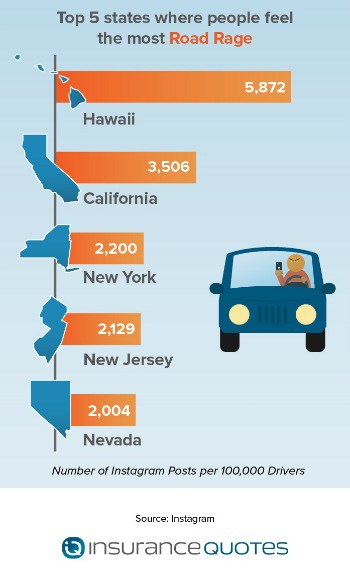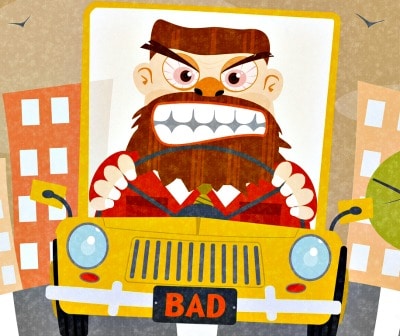When and Where Does Road Rage Most Often Strike?

Want to avoid angry drivers on your local highways? Then drive less in August — and on Fridays.
Motorists tend to be most annoyed — and most likely to suffer from road rage — while navigating the nation’s roads during the month of August and on Fridays, at least according to Instagram posts.
A study of Instagram posts with the #RoadRage found motorists tended to post most often about driving frustrations on Fridays and in August. This doesn’t necessarily mean that there are more road rage-fueled accidents or incidents during these times. But, this does show that motorists are frustrated enough with traffic to post more often about it on Instagram.
RELATED: How to Deal With Flood Damage to Your Car
More than 65,535 Instagram posts from June of 2013 through April of 2016 were hashtagged #RoadRage. The goal? To find out where and when U.S. motorists are feeling the most aggravated.
“Inconsiderate driving, bad traffic and the daily stresses of life can transform minor frustrations into dangerous road rage,” says Jurek Grabowski, former director of research for the AAA Foundation for Traffic Safety. “Far too many drivers are losing themselves in the heat of the moment and lashing out in ways that could turn deadly.”
When are angry motorists out
So, why August? According to the research, the month saw an average of 7,136 Instagram posts with the hashtag #RoadRage. That’s a significant number more than second-place month July, with an average of 6,203 such posts.
One reason might be that people tend to drive more often and farther distances in the summer months of August and July. Kids are out of school, and plenty of families are hitting the road for summer vacations. Those trips can be long ones, covering hundreds of miles. It makes sense, then, as people are driving longer, and on more crowded highways, that their feelings of traffic frustration would rise.
The months with the fewest number of #RoadRage posts are May, with an average of 3,737, and April with an average of 3,803. Why do these months have so many fewer road rage-related posts? It’s hard to say, but maybe there aren’t as many drivers on the road during these months.

Days of the week when road tempers flare
Then there are the days of the week. You’d think that most any weekday, what with morning and afternoon rush-hour commutes, would be equally filled with road rage posts. But you’d be wrong. The one day of the week in which Instagram posts with the hashtag #RoadRage are at their peak? It’s Friday.
What happens on Friday? It is the end of the work week. Maybe motorists grow increasingly frustrated with rush-hour traffic throughout the week and then, when they’re finally nearing the weekend, their anger boils over. That might explain why road rage Instagram posts soar to an average of 10,469 on Fridays. The high number of motorists leaving work early that day, cluttering roads for a longer period, might have an impact, too.
CHECK OUT: How Much Can You Save By Bundling Your Insurance?
Road rage posts tend to increase throughout the week, with Thursday seeing an average of 10,311 #RoadRage posts and Wednesday seeing 10,017. Tuesday sees an average of 9,914, while Monday sees an average of 8,674.
The calmest day on the roads seems to be Sunday. Findings show an average of 7,472 #RoadRage posts on that day, the lowest of any day of the week. There seems to be a fairly obvious reason for the drop of angry Instagram posts on the weekend: People generally aren’t commuting to work on these days. As people who’ve been stuck in traffic on the way to work can tell you, it’s one aggravating feeling, enough to lead to thoughts of road rage.

Road rage posts increase during the day, too. But it doesn’t necessarily follow the pattern you’d think.
You might expect road rage posts to soar during the morning rush hour, flatten a bit throughout the day, and then soar again as the evening rush hour arrives.
What actually happens, though, is that road rage posts rise throughout the morning, continuing to increase even as the morning rush hour ends, and then peak during the evening rush hour before gradually tapering off throughout the rest of the day.
Analysis found an average of more than 8,800 Instragram posts on road rage during the hours of 5 p.m. and 7 p.m., the hours when motorists are most likely fighting their way home after a long day of work. It’s little surprise that angry posts would peak during these traffic-clogged hours.
The hour of 6 p.m. sees the most road rage posts, with an average of nearly 4,500, according to the site’s research. Close behind is 5 p.m., where there were an average of more than 4,200 #RoadRage posts.
Angriest states for road rage

A final interesting note from the road rage study is that drivers in Hawaii are the most aggravated by traffic.
Hawaii saw 5,872 road rage Instagram posts per 100,000 drivers, the highest rate of any state in the country.
Why? Hawaii’s traffic is notoriously bad, with traffic in the state’s largest city, Honolulu, ranked third worst in the nation in 2015 by the Tomtom Traffic Index. At the same time, Hawaii is packed with tourists. These out-of-state motorists are often traveling roads that they have never driven on before. This can lead to an increase in accidents and slow traffic that can frustrate the locals.
California ranked second with 3,506 Instagram posts per 100,000 drivers, while New York came in third with 2,200 posts.
How to stop road rage
What can be done about road rage? Hopefully having more road rage information out there will help people recognize the symptoms they see in themselves and work to stay calm.
One possible solution comes from Texas where the Arlington Police Department has a new road rage hotline to report aggressive drivers. Its purpose is to provide follow-up communication with registered owners whose cars have been reported to be involved in an aggressive driving incident.
Callers to the hotline provide contact information, a detailed description of the aggressive driver and vehicle involved, a general description of what happened and a location and time of the incident.
By providing a license plate of the alleged suspect vehicle, investigators follow-up with the incident. A letter will be mailed to the registered owner describing the allegation and provide tips on how to remain calm in traffic and safely diffuse future incidents.
“We hope to use this hotline as an additional tool to deter and report aggressive drivers in addition to our enforcement efforts,” says Lt. Jeff Pugh who commands the Traffic Unit. “We believe that there has been an increase in the frequency and severity of road rage type incidents on our area freeways.
“We will not tolerate driving behaviors that put the motoring public in danger and will deal with other criminal acts that occur in conjunction with aggressive driving.”
The department recently launched an aggressive driving task where officers work in covert capacities as well as marked units to detect, apprehend and enforce laws on roadways within the confines of the city of Arlington.
Officers look for aggressive drivers including excessive speeding, tailgating, unsafe lane changes, driving on improved shoulders to pass traffic, throwing objects at vehicles, brandishing weapons and other unsafe behaviors that can lead to road rage style incidents.
“Our goal is to ensure citizens are safe while traveling on our freeways,” says Police Chief Will Johnson. “There is absolutely no reason why someone should engage in aggressive driving behaviors that can lead to violence resulting in unnecessary injuries or even death.”
Editor’s Note: Analysts look at 65,535 Instagram posts from June 2013 through April 2016. Ranking of cities and states was based on the 5,183 posts that were geotagged. Instagram’s time stamps are in UTC (Coordinated Universal Time). We converted them to Eastern Standard Time by subtracting four hours. For the analysis of most frequently used words, we excluded common short terms unrelated to traffic.
In a situation where road rage causes an accident having the best car insurance coverage will help you with any damages to your vehicle caused by a road rage incident.
